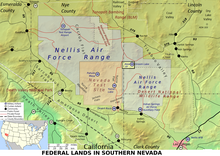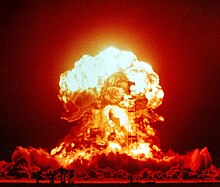Nevada National Security Site

The Nevada National Security Site (abbreviated NNSS ; until 2010 Nevada Test Site , NTS ; German National Security Area Nevada ) is a 3500 km² restricted area located within the Nellis Range north of Las Vegas in the US state of Nevada . The site has 28 different test sites, 1,100 buildings, 640 kilometers of paved roads, 480 kilometers of gravel tracks, 10 helicopter landing pads and 2 makeshift airfields.
Nuclear weapons tests
From 1951 to 1962, 119 above-ground nuclear weapons tests were carried out on the test site, and from 1962 to the test stop memorandum in 1992, over 1,000 underground nuclear tests were carried out. Some of the mushroom clouds from the aboveground atomic bomb tests could be seen as far as Las Vegas, about 100 kilometers away, and the seismic tremors could also be felt there. In addition to the nuclear weapons tests, there were numerous other physical tests, for which the unusual BREN Tower was built.
The film The Conqueror was shot on the nuclear weapons test site in the 1950s, although the health hazards caused by the nuclear weapons tests that had recently taken place were underestimated or not known. 30 years later, 91 members of the 220-strong film team had developed cancer, and in 1981 46 of those involved had died of cancer. These included u. a. director Dick Powell and cast John Wayne , Agnes Moorehead and Susan Hayward .
Rocket experiments
Numerous rocket experiments have been carried out at the Nevada National Security Site , including the nuclear powered NERVA rocket and even a nuclear ramjet . In the 1950s there were numerous launches of research rockets to study the clouds of explosion from the atomic bombs. In 1997, some sounding rockets of the Castor-Orbus type were launched at 36 ° 45 ' N , 116 ° 7' W on the test site .
Environmental monitoring
An ODL measuring network was set up around the area as part of the Community Environmental Monitoring Program , with which the air, ground and waterborne local dose rates are monitored. The monitoring network was established in 1981 and today has 29 probe locations in the states of Nevada , Utah and California . The headquarters of the monitoring network is the Western Regional Climate Center in Reno .
Today's problems
Under the Ruby Valley Treaty (1863), which guaranteed them two thirds of Nevada, the area is claimed by the Western Shoshone . For decades, the main entrance to the test site on US 95 (Mercury exit, 36 ° 36 ′ 9.5 ″ N , 115 ° 59 ′ 56.2 ″ W ) has been the destination of many anti-nuclear protests from all over the USA.
The controversial US nuclear repository under the ridge of Yucca Mountain , which has been stopped in the planning phase since February 2009, is partly located on the territory of the Nevada National Security Site .
Trial series on the Nevada proving ground
933 nuclear weapons tests were conducted at the Nevada National Security Site between 1951 and 1992.
See also
literature
- Carole Gallagher: American Ground Zero. The secret nuclear war in the USA (Original: Cambridge / USA 1993; German edition: Berlin 1995) ISBN 3-88520-547-5
Web links
- http://www.globalsecurity.org/wmd/facility/nts.htm (English)
- Nevada Test Site in the Encyclopedia Astronautica (English)
- http://nuclearweaponarchive.org/Usa/Tests/index.html (English)
- The Nevada Test Site Oral History Project , University of Nevada, Las Vegas (English)
Individual evidence
- ↑ http://www.upi.com/Top_News/US/2010/08/23/Nevada-nuclear-bomb-site-given-new-name/UPI-39551282594195/
- ^ Community Environmental Monitoring Program of the Department of Energy's National Nuclear Security Administration Nevada Field Office (NNSA / NFO) and the Desert Research Institute
Coordinates: 37 ° 8 ′ 10 ″ N , 116 ° 4 ′ 7 ″ W.





